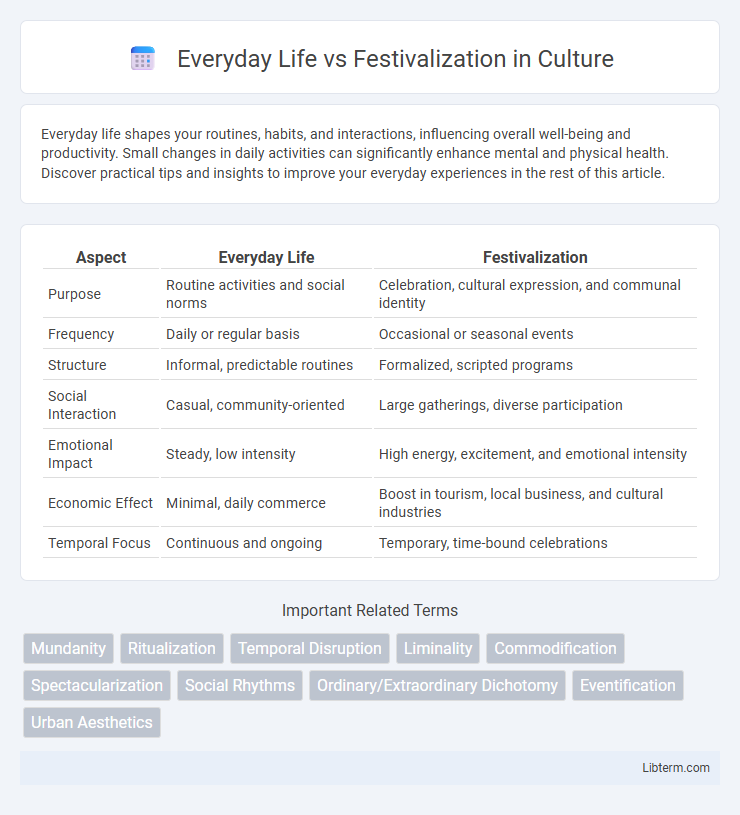Everyday life shapes your routines, habits, and interactions, influencing overall well-being and productivity. Small changes in daily activities can significantly enhance mental and physical health. Discover practical tips and insights to improve your everyday experiences in the rest of this article.
Table of Comparison
| Aspect | Everyday Life | Festivalization |
|---|---|---|
| Purpose | Routine activities and social norms | Celebration, cultural expression, and communal identity |
| Frequency | Daily or regular basis | Occasional or seasonal events |
| Structure | Informal, predictable routines | Formalized, scripted programs |
| Social Interaction | Casual, community-oriented | Large gatherings, diverse participation |
| Emotional Impact | Steady, low intensity | High energy, excitement, and emotional intensity |
| Economic Effect | Minimal, daily commerce | Boost in tourism, local business, and cultural industries |
| Temporal Focus | Continuous and ongoing | Temporary, time-bound celebrations |
Understanding Everyday Life: Patterns and Routines
Everyday life is characterized by repetitive patterns and routines that create a predictable structure, offering individuals a sense of stability and continuity. These habitual actions, from morning rituals to work schedules, anchor social interactions and cultural norms within communities. Understanding these patterns is crucial for analyzing how festivalization disrupts or complements daily rhythms by introducing episodic celebrations that contrast with or enhance the regular flow of life.
What Is Festivalization? A Modern Phenomenon
Festivalization is a modern phenomenon characterized by the transformation of everyday life into a series of events or celebrations, blurring the boundaries between routine activities and festive occasions. This process often involves the commercialization and amplification of cultural practices, turning ordinary spaces and moments into staged experiences designed for consumption and social engagement. Urban environments increasingly adopt festivalization as a strategy to boost tourism, local identity, and economic development through vibrant, recurring events.
Historical Context: Everyday Life vs Festivals
Historical context reveals that everyday life in traditional societies was governed by routine activities such as farming, craftsmanship, and communal living, embedding cultural norms and social structures into daily practice. Festivals, by contrast, punctuated this routine with ritualistic celebrations, often tied to seasonal cycles, religious observances, and social cohesion, serving as moments of collective identity reinforcement. The distinction highlights how festivals functioned as symbolic breaks from mundane life, preserving heritage and transmitting cultural values across generations.
The Blurring Boundaries Between Daily Life and Events
The blurring boundaries between everyday life and festivalization reflect a growing trend where routine activities increasingly adopt celebratory elements, transforming ordinary spaces into event-like experiences. Urban environments showcase this shift as public areas host pop-up markets, street performances, and cultural parades that merge daily social interaction with festival dynamics. This fusion influences social behavior, consumption patterns, and the organization of public life, highlighting how event culture permeates ordinary time and space.
Social Impacts of Festivalization on Communities
Festivalization transforms everyday life by concentrating social interactions into temporary, intense events that foster community identity, cultural expression, and economic vitality. It enhances social cohesion by attracting diverse groups, encouraging local participation, and creating shared experiences that strengthen communal bonds. However, it can also lead to social fragmentation, displacement of residents, and increased commercialization, challenging the balance between inclusivity and exclusivity within communities.
Economic Consequences: Routine Commerce vs Festival-driven Markets
Routine commerce sustains stable economic activity with predictable revenue streams from everyday consumer spending across diverse sectors like retail, food services, and transportation. Festival-driven markets generate significant but often short-lived economic spikes through increased tourism, event-specific sales, and temporary employment opportunities in hospitality and entertainment industries. This cyclical pattern can lead to market volatility, with businesses facing challenges in maintaining consistent cash flow outside festival periods.
Cultural Shifts: Celebrations, Media, and Identity
Cultural shifts in celebrations reveal a growing trend of festivalization, where everyday life adopts festival-like qualities, blending routine activities with heightened social engagement and symbolic expression. Media plays a pivotal role in amplifying this phenomenon by broadcasting and disseminating festival imagery and narratives, shaping collective identity and community belonging. This evolution transforms cultural practices, creating hybrid spaces where traditional rituals merge with contemporary lifestyles, reflecting dynamic identity construction and social cohesion.
Urban Spaces: Temporary Transformation vs Permanent Habits
Urban spaces undergo temporary transformation during festivals, activating public areas with vibrant activities, cultural events, and increased social interaction that deviates from everyday habits. Festivalization introduces dynamic spatial uses and enhances local economies, yet these changes remain ephemeral compared to the permanent routines and infrastructure shaping daily urban life. Understanding this contrast highlights how urban planning must balance flexible event-driven designs with sustainable, long-term community needs.
Psychological Effects: Escapism vs Stability
Everyday life provides psychological stability by offering routine and predictability that reduce stress and foster a sense of control. Festivalization promotes escapism, creating immersive experiences that temporarily remove individuals from daily pressures and encourage emotional release. Balancing stable daily environments with periodic festival experiences can enhance overall mental well-being by satisfying the need for both security and novel stimulation.
Navigating the Balance: Embracing Both Worlds
Navigating the balance between everyday life and festivalization involves integrating celebratory experiences without disrupting daily routines, enhancing well-being and social connection. Embracing both worlds requires mindful planning to incorporate cultural, artistic, and community events while maintaining productivity and personal responsibilities. This approach fosters a harmonious lifestyle where moments of festivity enrich routine living, promoting sustained happiness and cultural engagement.
Everyday Life Infographic

 libterm.com
libterm.com